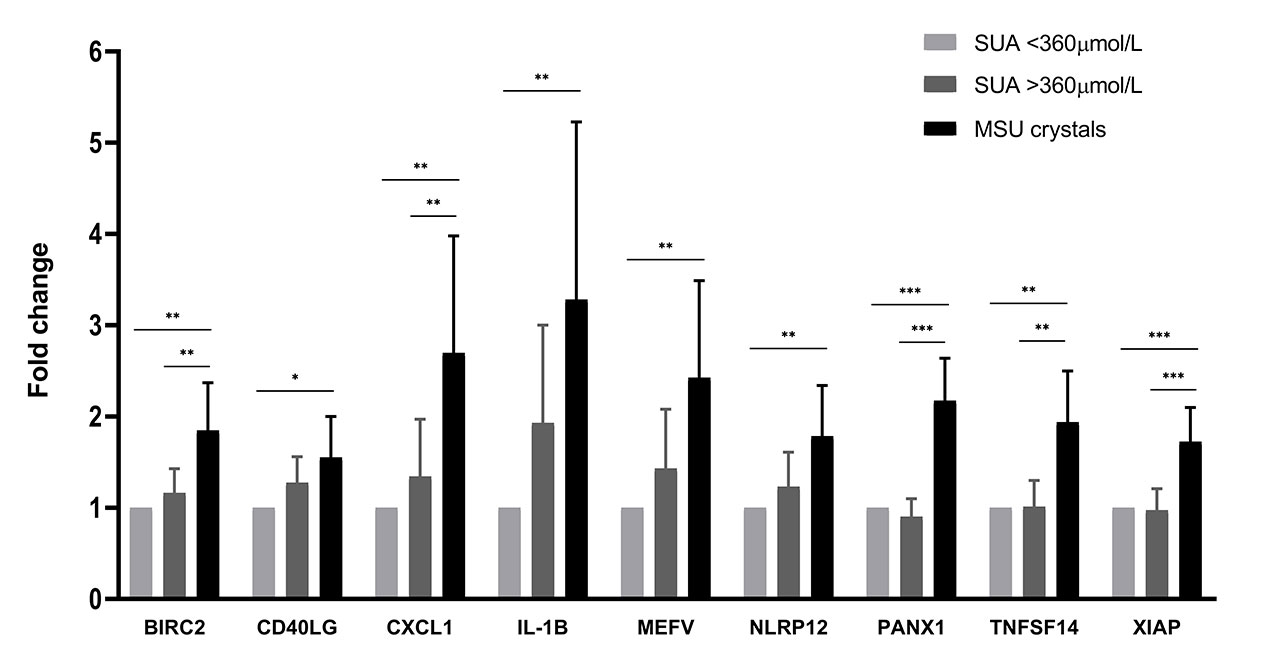Session Information
Date: Tuesday, November 12, 2019
Title: 5T112: Metabolic & Crystal Arthropathies II: Genetics & Physiology (2834–2839)
Session Type: ACR Abstract Session
Session Time: 4:30PM-6:00PM
Background/Purpose: Persistent hyperuricaemia is a prerequisite for gout. However, only 10% of people with hyperuricaemia develop symptomatic gout, whereas 25-35% have asymptomatic monosodium urate (MSU) crystal deposits. Whether these asymptomatic deposits are truly inert, or exert a sub-clinical pro-inflammatory effect is unknown. Since the immune response in gout is mediated primarily by the NLRP3 inflammasome, we hypothesized that the presence of MSU crystals in people with hyperuricaemia but no previous gout flares will initiate changes in the expression of inflammasome-associated genes.
Methods: Individuals recruited into the study were screened for serum urate (SU) levels and presence of MSU crystals within joints by ultrasonography. They were divided into 3 groups: (a) normal SU (< 360µmol/L) without MSU deposits; (b) high SU ( >360µmol/L) without MSU deposits; and (c) high SU with MSU deposits. Peripheral blood was collected in PAXgene blood RNA tubes and total RNA was extracted according to the manufacturer’s protocol. Quantitative RT-PCR was used to analyse the expression of 86 inflammasome and toll-like receptors (TLRs)-associated genes using a customised QIAGEN RT2 Profiler Array. Data were normalised to RPLP0, and the 2-ΔΔCT method was used to calculate fold changes. Differences in relative expression among groups were evaluated using the Kruskal-Wallis H test. P values were corrected for multiple testing using a false discovery rate of 5%. Genes were clustered into four groups, specifically NLRP3 inflammasome-assembly mechanisms, TLRs, NLRP3 inflammasome-effector mechanisms, and inflammasome down-regulators, to evaluate their variation across normouricaemia, hyperuricaemia, and hyperuricaemia with MSU crystal deposits. The models were evaluated using linear regression.
Results: After RNA extraction and cDNA synthesis, 92 samples passed the quality control parameters and underwent the expression profiling. There were 31 participants in the normouricaemic group, 44 in the hyperuricaemia only group, and 17 in the hyperuricaemia with MSU crystal deposit group. Out of 86 genes, 13 showed a significant difference among groups (adjusted p value < 0.05). However, only BIRC2, CD40LG, CXCL1, IL-1β, MEFV, NLRP12, PANX1, TNFSF14 and XIAP had a large upregulation (fold change >1.5) in at least one of the high SU groups, compared to the normal SU group (Figure 1). IL-1β had the largest fold changes in both high SU without MSU crystals and high SU with MSU crystals (1.9 and 3.3 respectively). Moreover, from the four gene-groups, the TLRs gene cluster showed the highest R2 (0.458), followed by the NLRP3 inflammasome-effector mechanism (R2=0.371), the R2 for inflammasome-assembly mechanisms and inflammasome negative regulators were 0.244 and 0.233 respectively.
Conclusion: The differences in the expression of immune-associated genes observed in this study suggest that initial MSU crystal deposition within joints, although asymptomatic, initiates the activation of pro-inflammatory mechanisms. These results only reflect systemic responses on gene-expression, and cytokine assay is underway. Further studies are needed to validate these results in synovial fluid samples.
To cite this abstract in AMA style:
Sandoval-Plata G, Morgan K, Guetta-Baranes T, Valdes A, Doherty M, Abhishek A. Asymptomatic Monosodium Urate Crystal Deposition Associates with Increased Expression of Pro-Inflammatory Genes [abstract]. Arthritis Rheumatol. 2019; 71 (suppl 10). https://acrabstracts.org/abstract/asymptomatic-monosodium-urate-crystal-deposition-associates-with-increased-expression-of-pro-inflammatory-genes/. Accessed .« Back to 2019 ACR/ARP Annual Meeting
ACR Meeting Abstracts - https://acrabstracts.org/abstract/asymptomatic-monosodium-urate-crystal-deposition-associates-with-increased-expression-of-pro-inflammatory-genes/

